 Image search results - "takao" Image search results - "takao" |

One of Japan's three Big Buddhas (after Nara and Kamakura). The statue was built by local coppersmiths in 1932, taking 30 years to complete.
|
|

JR Takaoka Station (north side) 高岡駅
|
|

The Takaoka Daibutsu stands 15.85 meters high, weighing 65 tons. Japan's largest copper statue. Takaoka, Toyama
|
|

Inside Takaoka Station passage
|
|

In front of JR Takaoka Station (north side)
|
|

In fall 2007, it underwent major renovation.
|
|

Sculpture in front of Takaoka Station (north side)
|
|
|

Sculpture in front of Takaoka Station (north side)
|
|

JR Takaoka Station (south side)
|
|

Shopping street near Takaoka Station
|
|

Sculpture along a shopping street
|
|

The name of the festival is "Hiwatari," literally meaning fire crossing. They make a big fire, then allow people to walk over the embers. This is the centerpiece of the festival, a pile of cypress tree branches to be burned.
|
|

This festival is held on the second Sunday every March at the foot of Mt. Takao. It takes less than an hour from Shinjuku via the Keio Line. Train fare is only 370 yen. The pile of tree branches is supported by a wooden framework. A priest pours kerosene.
|
|

The festival site is a short walk from Takao-san-guchi Station. It's held in this large lot cordoned off by a sacred rope. This festival is held as a prayer for traffic safety, household safety, and personal safety. It is held by the Yakuoin Yukiji Te
|
|

Various ceremonies, rituals, and chanting takes place during one hour from 1 pm. Divine ax used to cut away earthly desires.
|
|

Divine arrow to ward off any life-threatening devils. The festival is executed by the mountain ascetic priests called yamabushi.
|
|

He shoots an arrow into the pile from the four corners.
|
|

This long torch will be used to ignite the pile.
|
|

The pile is first ignited from two sides.
|
|
|
|
|

The pile catches fire very easily due to the kerosene. Even at this distance, it gets very hot. Also see the video at YouTube.
|
|

Dai-hiwatari Festival, Mt. Takao, Tokyo
|
|

She was tossing out these paper things to the crowd.
|
|
|
|
|
|
|
|

Raking the fire. They are making the footpath for fire walkers.
|
|

Raking the fire
|
|

This priest splashed the boiling contents of this pot over himself.
|
|

Head priest
|
|

Blessing the path
|
|

First the priests walked on the fire.
|
|

Walking on fire
|
|

Hiwatari fire-crossing festival, Mt. Takao, Tokyo
|
|

Before and after walking over the fire, they stick their feet into a pile of salt.
|
|

After crossing the fire, each person is blessed by the head priest with a tap on the shoulder by a baton.
|
|

After the priests, the general public is invited to stand in line and cross the fire for free.
|
|

I always wondered how hot it was to walk on the fire, so this time I decided to walk over the fire just to see how much heat my feet could bear. Also see the video at YouTube.
|
|

Long line: It took us over 30 minutes to reach the fire.
|
|

End of the line. It reads, "Saikobi."
|
|

Everyone crosses barefoot, so we took off our shoes as we approached the fire crossing.
|
|
|

First we pass through a gauntlet of chanters.
|
|

Then we stick our feet in salt.
|
|

This is what it looked like by the time we got there. Hardly any fire. It was somewhat wet, and it did not feel hot or warm at all. Pretty disappointing...This is what it looked like by the time we got there. Hardly any fire. It was somewhat wet, and it did not feel hot or warm at all. Pretty disappointing...
|
|

End of the walk. Again we dip our feet in salt. We all ended up with muddy feet. There was no place to wash our feet either. Bringing wet tissues is highly recommended if you plan to walk on the fire.
|
|

Priests parade back to temple.
|
|

Yamabushi--mountain ascetic priests. They carried a conch-shell-like instrument.
|
|
|
|

Back at the Yakuoin temple which belongs to the Shingon Sect of Buddhism. 薬王院
|
|

Costume gals. Even these girls walked on the fire.
|
|

Zuiryuji Temple is a 10-min. walk from the south side of JR Takaoka Station. This is the white stone path (called Hatcho-michi 八丁道) leading to the temple. Go in the opposite direction to reach Lord Maeda Toshinaga's grave.
|
|

Statue of Maeda Toshinaga, the 2nd lord of the Kaga domain and founder of Takaoka. The Hatcho-michi path is also lined with numerous pine trees, cherry trees, and 54 stone lanterns. It is 870 meters long between Zuiryuji and Lord Toshinaga's gravesite
|
|
|

Maeda Toshinaga, the 2nd lord of the Kaga domain and founder of Takaoka
|
|

Temple admission is 500 yen for adults. First you see the Somon Gate which is an Important Cultural Property. 総門
|
|

Pass through the Somon Gate and you see the Sanmon Gate flanked by two corridors. In front is a plaza of pebbles. 山門
|
|

Belonging to the Soto sect of Zen Buddhism, the temple is dedicated to Maeda Toshinaga, the 2nd lord of the Kaga domain and founder of Takaoka. The temple has three buildings designated as National Treasures.
|
|

Modeled after Chinese temple architecture common during the Kamkura Period, the temple layout is said to resemble the human body, with the head at the top on this map. Three temple buildings were designated as National Treasures in 1997.
|
|

Zuiryuji's Sanmon Gate, a National Treasure. The original Sanmon Gate was built in 1645, but was lost in a fire in 1746. The present gate was built in 1820. 山門
|
|

Sanmon Gate
|
|

Passing through Sanmon Gate
|
|

After passing through Sanmon Gate, you see the Butsuden Hall, another National Treasure. 仏殿
|
|

Zuiryuji Butsuden Hall was built in 1659. The roof has lead plates. A magnificent example of Zen architecture. Takaoka, Toyama.
|
|

Side view of Butsuden Hall
|
|

Rear view of Butsuden Hall
|
|

Corner view of Butsuden Hall
|
|

Inside Butsuden Hall 仏殿
|
|

The high, open ceiling made of wood is most impressive even to the layman.
|
|

Ceiling of Butsuden Hall
|
|

Butsuden Hall
|
|

Butsuden Hall
|
|

Butsuden Hall
|
|

Butsuden Hall
|
|

Butsuden Hall
|
|

Butsuden Hall
|
|

Butsuden Hall
|
|

On the left of the Butsuden is Zendo Hall for zazen meditation training as well as for eating and sleeping for priests. The building is an Important Cultural Property. 禅堂
|
|

On the right of the Butsuden is the Oguri Hall which has kitchen and temple office facilities. The building is an Important Cultural Property. 大庫裏
|
|

Corridor connecting the Sanmon Gate and Zendo Hall.
|
|

Meditation seats inside Zendo Hall
|
|
|

Meditation seats inside Zendo Hall
|
|

Inside Zendo Hall
|
|

Corridor from Zendo Hall to Hatto Hall
|
|

View of Butsuden and Sanmon Gate
|
|

Sekibyo graves where the partial remains of Lords Maeda Toshinaga and Toshiie and even Oda Nobunaga are buried. 石廟
|
|

Hatto Hall 法堂
|
|

Zuiryuji temple's Hatto is the temple's main worship hall built in 1657. A National Treasure. Takaoka, Toyama. 法堂
|
|

Hatto Hall
|
|

Hatto Hall
|
|

Hatto Hall
|
|
|
|

Inside Hatto Hall
|
|

Altar inside Hatto Hall
|
|

Hatto Hall
|
|

Ceiling tiles with flower paintings by Kano Yasunobu in Hatto Hall
|
|

Minor altar in Hatto Hall
|
|

Room in Hatto Hall
|
|

Hatto Hall, where you take off your shoes.
|
|

Hatto Hall
|
|

Inside the Daisado Tea Room which is to the right of the Hatto. Important Cultural Property. 大茶堂
|
|

Inside the Daisado Tea Room 大茶堂
|
|

Stone lantern
|
|

Bell tower behind the corridor
|
|

Corridor from Hatto Hall to Oguri Hall
|
|

Corridor
|
|

Rear of Sanmon Gate as seen from the Butsuden
|
|

Sanmon and Butsuden
|
|
|

Kitchen in Oguri Hall
|
|
|

Corridor and Sanmon Gate
|
|

Corridor connected to Sanmon Gate
|
|

Corridor wall ornament
|
|

Entrance to the gravesite of Lord Maeda Toshinaga, about 870 meters away from Zuiryuji. (Maeda Toshinaga Bosho 前田利長墓所)
|
|

Path to gravesite
|
|

Grave of Lord Maeda Toshinaga is surrounded by a moat (which we cannot cross). The monument stands 11 meters high. The grave is one of Japan's largest for a feudal lord. 前田利長墓所
|
|

Takao Baigo is in the area of the famous Mt. Takao. It's an area with several plum blossom groves mainly along a road called Kyu-Koshu Kaido (旧甲州街道) near JR Takao Station and Keio Line Takaosanguchi Station.
|
|

Takao Baigo is in the area of the famous Mt. Takao. Plum blossoms here bloom in March, so if you were too busy to see plum blossoms in Feb., you can still see the ume blossoms in mountainous western Tokyo.
|
|

Takao Baigo was established in 1964 by a local tourist group. They happened to have multiple plum groves in this area, so they decided to market them together as a tourist attraction named "Takao Baigo" (Takao Plum Blossom Area).
|
|

Red plum blossoms really stand out.
|
|

Takao Baigo is near JR Takao Station and Keio Line Takaosanguchi Station. JR Takao Station has this giant tengu mask on the platform. Mt. Takao, which has long been a sacred mountain, supposed to be where one of the major tengu dwells. So the tengu is a local symbol.
|
|
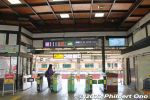
JR Takao Station. Takes a little over an hour from Tokyo Station on the JR Chuo Line.
|
|

JR Takao Station. Get out the north exit (Kitaguchi).
|
|

From the north exit,go left to the bus stops to catch a us to Takao Baigo. Otherwise, it's a 15-min. walk.
|
|

Buses run only once an hour on weekdays and two or three times per hour on weekends. Take the bus going to Kobotoke (小仏).
|
|

When I took the bus from Takao Station in mid-morning, it was packed even on a weekday during peak bloom.
|
|

You can see the plum groves either from the start of the road or from the end of the road where the largest plum grove is located. I took the bus to the end and walked back toward the train station.
|
|

If you want to see the largest plum grove first (Kogesawa Bairin), get off here at the Oshimo stop (大下). Takes about 20-30 min. from Takao Station.
|
|

Bus stops between the two nearest train stations and Takao Baigo.
|
|

From the Oshimo bus stop, walking to Kogesawa Bairin. A short walk.
|
|

Walking to Kogesawa Bairin.
|
|

Walking to Kogesawa Bairin near the Chuo Expressway overhead. (木下沢梅林)
|
|

Kogesawa Bairin near the Chuo Expressway overhead.
|
|

Gate to Kogesawa Bairin. All the plum groves have free admission. Kogesawa Bairin is open to the public only when the flowers are on bloom. Otherwise, it's closed to the public (surrounded by a fence).
|
|

Kogesawa Bairin is on a hillside with walking paths along the trees. Mostly white plum blossoms, but a few red and pink flowers too. ("Bairin" means "plum grove.")
|
|
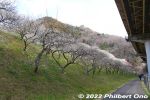
Walking up to the top of Kogesawa Bairin along this path on the periphery.
|
|

Kogesawa Bairin is on a hillside.
|
|
|
|
|
|

The plum grove has walking paths across the slope.
|
|
|

On the top of Kogesawa Bairin, there are benches and picnic area near the plum trees.
|
|

Top of Kogesawa Bairin with benches and picnic area near the plum trees.
|
|

Top of Kogesawa Bairin with benches and picnic area near the plum trees.
|
|

Top of Kogesawa plum grove hill has this small area for picnickers. A few benches and tree stumps to sit on. Good idea to bring takeout food. Pleasant to have lunch here.
|
|

Top of Kogesawa Bairin.
|
|
|

Top of Kogesawa Bairin.
|
|

Top of Kogesawa Bairin. Plum tree branches seem to grow in random directions, but the tree always maintains its balance.
|
|
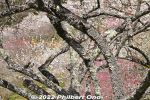
Plum trees also have lichens growing on the trunk and branches. These lichens form on plum trees in rural areas. We don't see them on plum trees in the city because exhaust fumes from vehicles kill them. So if you see these lichens on plum trees, it means the surrounding environment is very clean. (Parmotrema tinctorum ウメノキゴケ)
|
|
|

Looking down the hillside of white plum trees.
|
|

Steps going down hill of plum trees at Kogesawa Bairin.
|
|
|
|
|

Kogesawa Bairin hillside walking path.
|
|
|

Some plum trees with pruned branches. May they flower again someday.
|
|

The grove is near the mountains, so there's a nice backdrop.
|
|
|
|
|
|
|
|
|
|
|
|
|
|
|
|
|
|

Another nice spot for a picnic.
|
|
|
|
|
|
|

Walking path near the Chuo Expressway.
|
|
|
|
|
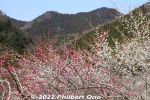
Kogesawa Bairin
|
|
|
|
|

Kogesawa Bairin
|
|

Kogesawa Bairin
|
|

Kogesawa Bairin
|
|

Kogesawa Bairin plum grove at Takao Baigo, Hachioji, Tokyo.
|
|

Kogesawa Bairin plum grove at Takao Baigo, Hachioji, Tokyo.
|
|
|
|
|

Kogesawa Bairin from outside the fence at ground level.
|
|

Kogesawa Bairin
|
|
|
|
|
|
|
|
|
|
|
|
|
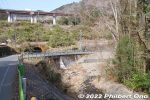
After Kogesawa Bairin, walked along on Kyu-Koshu Kaido road to see more plum groves.
|
|
|
|
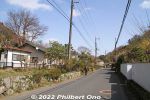
It's a quiet, rural, residential area along a small river. As you keep walking, you see plum trees here and there.
|
|

Bus stop
|
|
|
|
|

Pruning plum trees.
|
|
|
|

Kobotoke River and plum blossoms.
|
|
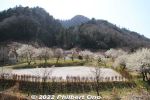
The next plum grove was Surusashi Bairin (するさし梅林). This might be the second largest plum grove in Takao Baigo.
|
|

Surusashi Bairin (するさし梅林) is also gated and open to the public only when the flowers are in bloom.
|
|

Surusashi Bairin grove covers a long, rectangular area. This is one end of it.
|
|
|
|
|
|

Surusashi Bairin has just one main path in the middle. The Chuo Expressway (goes to Nagoya via Nagano) is in the background.
|
|

Surusashi Bairin
|
|

Surusashi Bairin
|
|

Surusashi Bairin
|
|

Other end of Surusashi Bairin.
|
|

Since they are so few in Takao, the red plums really stand out.
|
|
|

Other end of Surusashi Bairin.
|
|
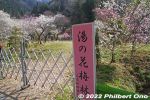
Walked further along the road for the next grove named Yunohana Bairin (湯の花梅林).
|
|

The public cannot enter Yunohana Bairin, so you just see it from the road.
|
|

Yunohana Bairin
|
|

Yunohana Bairin
|
|

Yunohana Bairin
|
|

Riverside path.
|
|

Riverside path map.
|
|

A grove named Takao Ume-no-Sato Machi-no-Hiroba.
|
|

Takao Ume-no-Sato Machi-no-Hiroba is more for picnicking.
|
|

Takao Ume-no-Sato Machi-no-Hiroba
|
|

Takao Ume-no-Sato Machi-no-Hiroba has restrooms.
|
|

Takao Ume-no-Sato Machi-no-Hiroba
|
|

Takao Ume-no-Sato Machi-no-Hiroba is right under the expressway.
|
|

Map of Takao Baigo.
|
|

Map of Takao Baigo.
|
|

Takao Baigo stone monument at Takao Ume-no-Sato Machi-no-Hiroba.
|
|

Takao Baigo stone monument at Takao Ume-no-Sato Machi-no-Hiroba.
|
|
|
|